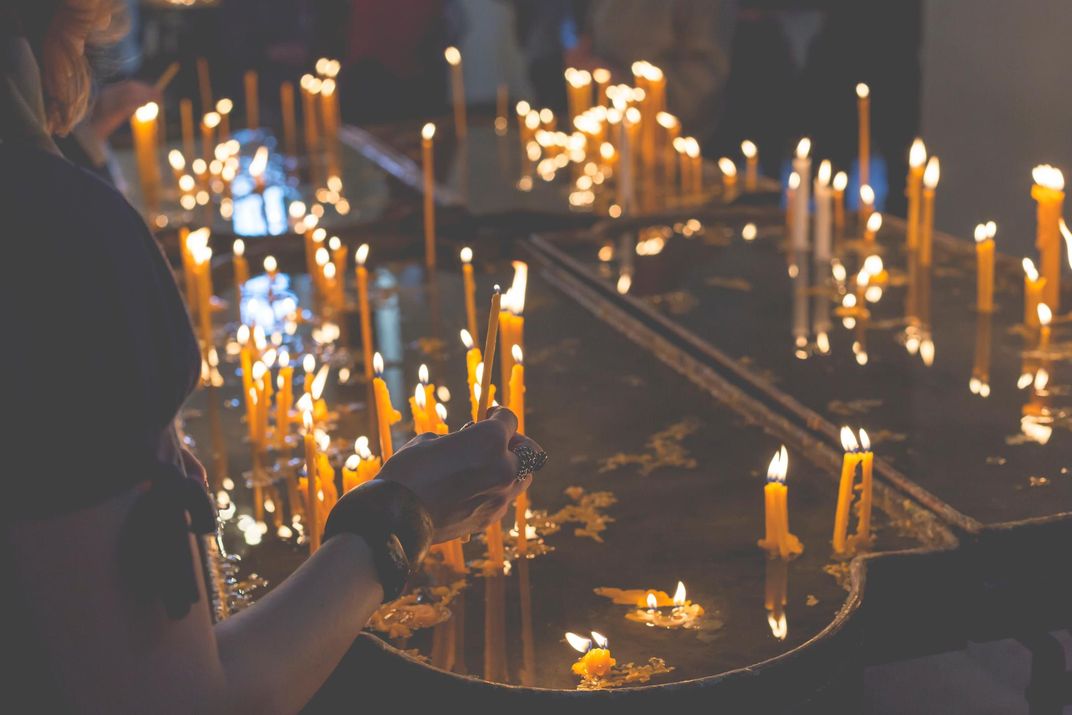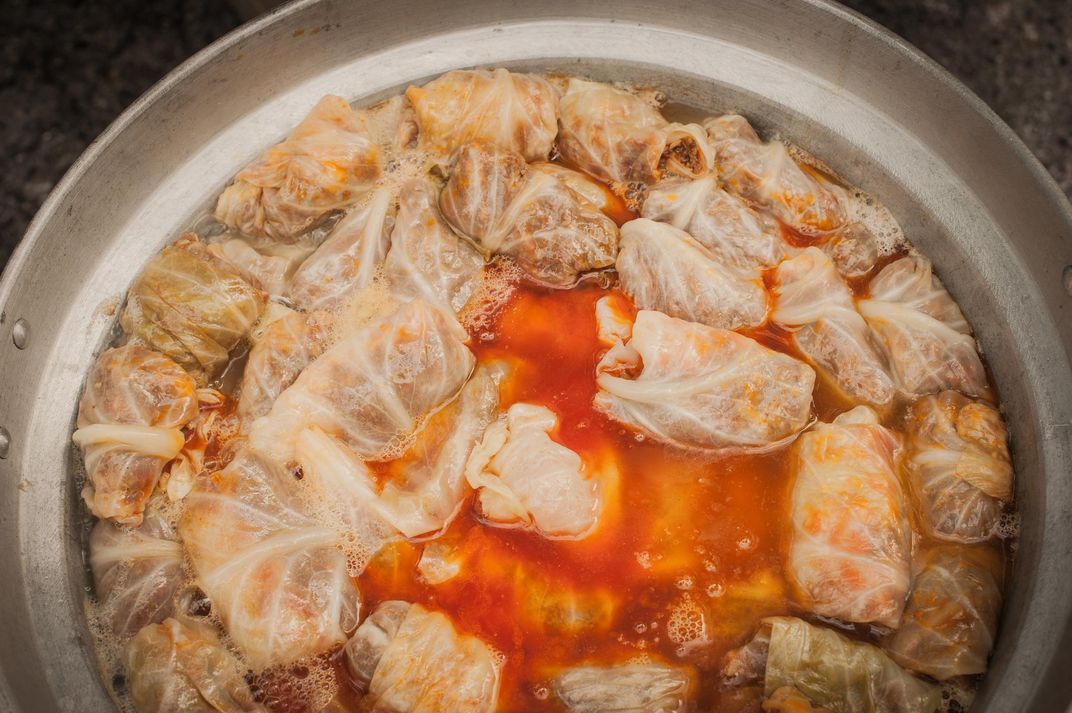It’s Still Christmas in Armenia
The holiday celebrations continue through January 13. Here’s what to cook to keep the festivities going.
/https://tf-cmsv2-smithsonianmag-media.s3.amazonaws.com/filer/45/84/4584b7ec-0292-4b55-86aa-ab6f50244733/istock-516003520_1.jpg)
The New Year marks the end of the holiday season in the United States, but in Armenia they are just getting started. There, first comes the New Year, then comes Christmas. New Year’s Eve kicks off two weeks of holidays during which Armenians celebrate Christ’s Nativity, his Baptism and the Epiphany. From December 31 to January 13, Armenian families visit family and friends, exchange gifts, and come together to drink and feast.
Just before midnight on New Year’s Eve, Ruzanna Tsaturyan, co-curator for the 2018 Smithsonian Folklife Festival program, Armenia: Creating Home, and her family gather around the dining table for the countdown. After kisses and toasts, the banquet begins. The table is laden with a lavish spread of ham, stuffed cabbage, cheeses, cured meats, cakes and plenty of good drink.
“The table should be so covered with food that you cannot even put your hand down,” Ruzanna says. “And everyone must eat a bit of everything.”
A special sweetbread called tarehats, meaning “New Year’s bread,” is an important part of the meal. Similar to a Three Kings Cake, a bean, coin or small button is baked into the bread. Armenians believe that the person who finds the trinket in their slice will enjoy good fortune in the coming year. Ruzanna says that when she was the lucky one, she kept her charm in her wallet until the next tarehats was cut.
“The winter grandfather,” a Santa Claus-like figure, also makes an appearance on New Year’s Eve. In more traditional households, children wake up to find presents under their pillows. Many enlist a family friend or neighbor to dress up and distribute gifts to their little ones. At Ruzanna’s house, the winter grandfather is more enigmatic. There is a knock at the door, and when the children go to answer it, they find their presents on the stoop or on the front lawn.
During Soviet rule from 1920 to 1991, religious practices were forbidden, and according to Ruzanna it hugely influenced the way Armenians celebrated the holidays. In an effort to secularize the season, the state made a concerted effort to shift the focus from Christmas to the New Year. This way, the festivities could continue without religious connotations. Many Armenian families therefore kept their prayers and Christian practices discreetly within their home.
When the Soviet Union collapsed, the older traditions, many of which had been dormant for the past seventy years, were revived. Churches around the country began organizing liturgies and teaching parishioners how to observe holy days or religious holidays. Ironically, the Armenian Apostolic Church adopted Christianity in 301 CE, making Armenians one of the world’s oldest Christian communities. Until the fourth century, most Christians celebrated the birth of Christ in early January. The Roman Catholic Church shifted the date to December 25 to coopt pagan winter solstice celebrations. However, because Armenians belong to the Apostolic Church, they continued to celebrate Christmas in early January.
On Christmas Eve, January 5, Armenians light their homes and churches with candles to illuminate the end of dark days and long nights. Christmas Day is known to Armenians as Water Blessing Day to commemorate Christ’s baptism; holy water, blessed by the head priest, is shared with families in the community.

“We wash our hands with this water and put it on the parts of our bodies that need care,” Ruzanna says.
The water cleanses the body and the home and its blessing gives protection from sickness or misfortune in the year to come. Sometimes, priests are invited to the home to bless the corners of the house, as well as food staples like bread and salt. Afterwards, families sit down to a special meal of fish—usually trout—and rice pilaf with raisins. They drink red wine, symbolizing the blood of Christ.
The day after Christmas is a Memorial Day, an occasion to remember loved ones who passed away during the year. People visit the intricately carved tombstones, or khachkars, of late friends and family, and adorn them with flowers or present offerings of food from the Christmas table. They recount stories about the departed and give elaborate toasts in their memory.
The holidays end on January 13, making the start of the “Old” New Year. The date is a remnant of the Julian calendar, which was subsequently replaced by the Gregorian calendar in most countries.
In Armenia, New Year and Christmas traditions blend together. The standard holiday greeting is “Happy New Year and Christmas!” and families decorate “holiday trees” at home. This time is about beginnings: the birth of Christ as well as the start of a new year.
***
Recipe: Armenian Lenten Cabbage Tolma for New Years

To Ruzanna and her family, and many others, it is not New Years without a mouth-watering tolma of pickled cabbage leaves with grains and beans, which is called Պասուց տոլմա Pasuts Tolma, or Lenten Tolma. The recipe for this treat is passed down from mother to daughter and each region has its own spices for it. Most of the recipes are not written down, but learned by watching and measured in “eye size or hands experience,” as they say in Armenia. The preparation is demanding, but the results are delicious and healthful, and will bring a taste of Armenia’s delicious cuisine to your table. Ruzanna shares her family’s recipe here.
Pasuts Tolma (Stuffed Marinated Cabbage)
- ½ cup each of dried beans, lentils, chickpeas, bulgur wheat and uncooked rice
- 1 16 oz. can tomato sauce
- 1 large yellow onion
- ¼ cup olive or vegetable oil
- 1-2 tablespoons of dried barberries or buckthorn berries (see note) or 1 tablespoon of dried thyme if unavailable
- Salt and pepper to taste
- 1 large head of green cabbage (in Armenia, they use cabbage that has been pickled)
- 2 cups of prepared rosehip juice or 4 tablespoons of tomato paste whisked into 2 cups warm water (see note)
The night before cooking, soak the legumes and grains in enough water to cover, each in a separate bowl, to soften. In the morning, cook the legumes grains until soft—the beans will take longer than the grains. Cook onions in oil until dark golden brown and caramelized (about 10 minutes), add tomato sauce and bring to a simmer. Add cooked grains and barberries, buckthorn or thyme, as well as salt and pepper to taste, and mix until well incorporated.
Prepare cabbage leaves by steaming the head of cabbage until leaves are soft and pliable. (When using pickled cabbage leaves in Armenia, the salt is washed off.) To roll each tolma, place a large cabbage leaf on a flat surface, add a large spoonful of the grain mixture in the center and roll while folding the sides in toward the center. This takes some practice to do well! Place some extra cabbage leaves that were not the best for rolling in the bottom of a large heavy saucepan or Dutch oven. Arrange the tolma in a circle or spiral in the bottom of the pot. Once all the tolma are arranged, pour prepared rosehip juice or tomato paste mixed with water over the rolls. Place more cabbage leaves on top, invert a heavy plate on top, bring to a boil and then down to a simmer for about 30 minutes or until softened and cooked through. Enjoy as part of your New Year’s feast! Bari akhorjak Բարի ախորժակ, bon appetite!
Note on barberries and buckthorn: It is easy to find dried barberries or buckthorn berries on Amazon or in Middle Eastern markets.
Note on preparing rosehip juice: Rosehip juice is a good source of vitamin C, and adds a lovely rose hue and a distinctive flavor to these tolma. To prepare your own rosehip juice: Add boiling water to dried rosehips, which can be purchased on Amazon or at a health food store. Leave them for in the water overnight, and strain the juice. You will need about two cups for this recipe. As an alternative, tomato paste whisked into water works as a colorful replacement.
Planning Your Next Trip?
Explore great travel deals
Smithsonian magazine participates in affiliate link advertising programs. If you purchase an item through these links, we receive a commission.